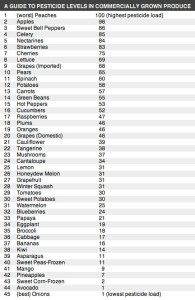 With part 2 of this Shop For Health series I would like to look at priorities when purchasing fruit and vegetables….
With part 2 of this Shop For Health series I would like to look at priorities when purchasing fruit and vegetables….
Q: “What is my top recommendation for parents when it comes to fruits and vegetables?””
STEP 1: Organic or not – focus on getting your children eating more fruits and vegetables, and use a Fruit & Vegetable Wash.
Too many of our children today self limit their diet and rely on packaged foods. Countless studies and literature reviews tell us that today’s children are deficient in a wide range of vitamins and minerals—key ingredients that allow their minds and bodies to function well. Our children are literally starving for good nutrition.
Focus on reducing the number of false, lifeless foods in your house and supply an abundance of fruits and vegetables for your children to snack on. Sure initially they may resist change but in Lunchbox Solutions we share with parents a number of simple ways to overcome barriers and how to encourage children to eat healthy wholesome foods.
If you are unable to buy organic produce the next best alternative is to wash commercial produce with a specific ‘fruit and vegetable wash’ and then rub them down with a ‘fruit and vegetable cloth’.
You can buy fruit and vegetable washes online and in health food stores. These washes remove a large percentage of the chemical residue that lies on the surface of the fruit. These washes use a combination of plant based nonionic surfactants, vegetable glycerin, potassium salts and water.
In my experience, these washes work well but with heavily waxed fruits such as apples, you will also need a fruit and vegetable cloth – which helps to physically removes excess polishes. The company ‘Enjo’ make a great cleaning cloth specifically for this task. If there have been times that I cannot source organic apples I will use a fruit and vegetable wash and I will then peel the apples as well as I just do not feel comfortable with the wax residue that may partially remain on the apple skin.
STEP 2: Consider What Organic You May Be Able To Afford?
Commercially grown produce tends to have an unnatural shelf life, is nutrient-poor, is grown with pesticides and chemicals, and can be genetically modified. Frighteningly, it can also be irradiated.
For many people the extra expense of organic food can be a turn off but it can help to understand that the higher price charged for most organic foods reflects the true cost of producing it—it is generally more labour intensive and the “real” inputs involved (as opposed to chemical inputs) are also more expensive.
Accommodating these costs in your budget can simply be a matter of habit and priority—in fact, reprioritising the budget is an important priority. If you reduce the amount you spend on things like expensive soft drinks, packaged food, take-away food or alcohol, you will likely find some spare money for high quality food. Be selective when budgeting for organic produce. There are key commercial fruit and vegetables that should best be avoided due to high levels of pesticides. The EWG (www.ewg.org), a not-for-profit environmental research organisation, has developed a pesticide guide for fruits and vegetables which makes for valuable reading: www.foodnews.org

The produce ranking was developed by analysts based on the results of nearly 43,000 tests for pesticides on produce collected by the US Department of Agriculture and the US Food and Drug Administration between 2000 and 2005. The results would be very similar here in Australia. Please see the EWH Chart shown to the right (click to enlarge)…
If you want your children to fall in love with fruits and vegetables, then one of the first things you can do is make the switch to organic produce. These fruits and vegetables may not always look better than the supersized strawberries or glossy waxed apples in supermarkets, but most of the time they taste so much better.
STEP 3: Move towards buying organic foods and produce whenever possible
Along with all its nutritional and taste advantages, organic produce tends to be in season and is often grown locally, which lowers our carbon footprint and encourages us to learn to cook with foods that we wouldn’t normally. Commercially grown produce, on the other hand, can contribute to the loss of biodiversity of our plants and animals, and damage our soils and waterways. Caring for our beautiful planet is always an important factor to consider.
There are now many organic shops that stock a wide variety of products. Some fruit and vegetable shops, health food stores and supermarkets have organic ranges and they may also carry selections of organic baby foods.
. . . . .
Further Info:
- Which Foods When eBook for more detailed information about nutrition for infants and young children.
- Lunchbox Solutions interactive eBook for information and over 70 easy recipes and healthy lunch ideas.
. . . . .
Warmly,
Jennifer Barham-Floreani
Bach. Chiropractic, Bach. App Clinical Science
Registered internationally, no longer practicing as a chiropractor in Australia.


 With part 2 of this
With part 2 of this 
